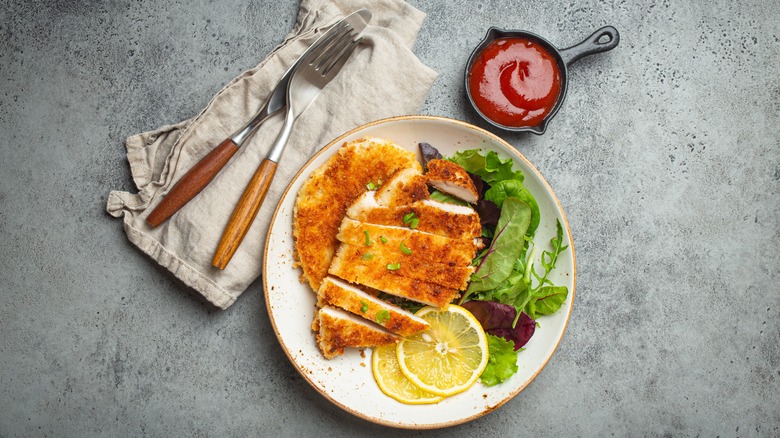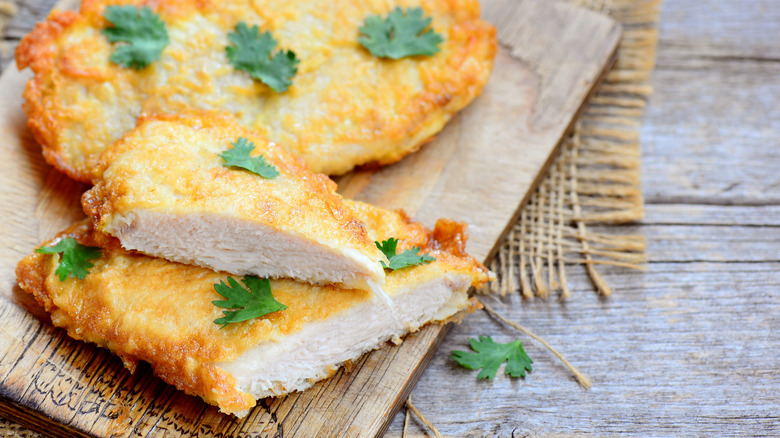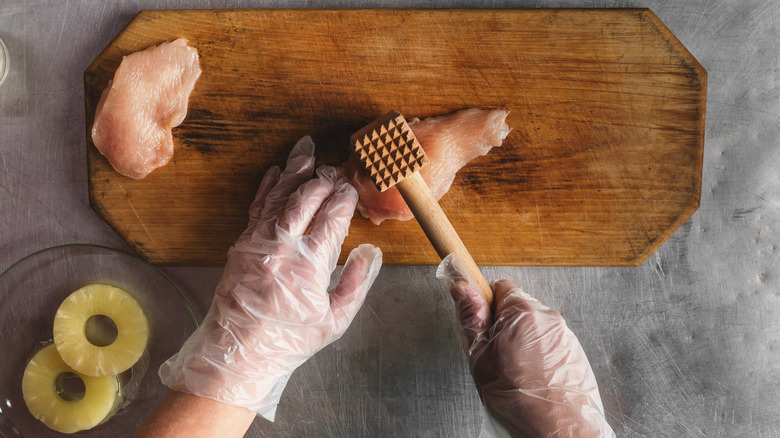How Breading Chicken Breasts Can Prevent Overcooking
No kitchen skill may be as useful as learning how to cook a juicy chicken breast. Whether you're chopping it up as a salad topping or making buttermilk-baked chicken for dinner, nailing the cooking time for this ingredient guarantees a succulent meal. However, chicken breasts are an extremely lean protein, and overcooking can easily turn them into a tough, rubbery mess. Combined with the fact that you can't serve chicken rare without running the risk of foodborne illnesses like salmonella, you might feel as if getting perfectly cooked chicken breasts at home is next to impossible. However, breading your poultry could be all you need to do to prevent this issue.
While breading does not lock in moisture in your meat, it serves as a barrier between your chicken and the hot, oily pan. This method also ensures you get a nice, crispy exterior without having to sear the exterior of your chicken directly, giving you more wiggle room to remove your poultry once it reaches the USDA's recommended internal temperature of 165 degrees Fahrenheit.
Keep the breading on by thoroughly drying your chicken breast
No amount of batter will prevent overcooking if it falls off the surface of your cutlets. Therefore, you must ensure that your chicken breasts are thoroughly breaded, and that their coating does not break apart during the cooking process.
Before coating your chicken breasts in batter, be sure to dry the surface of your cutlets. This will help ensure that moisture does not loosen the breading prior to cooking, reducing the chances of it falling off. Don't be shy during the coating process either; you want to make sure all sides of your cutlet are covered with crumbs and shielded from the hot pan.
More often than not, overhandling breaded chicken as it sears in a skillet results in its exterior crumbling apart. While it may seem counterintuitive, it's best to leave your breaded chicken alone as it cooks. Minimizing the number of times you poke, shove, and flip each batter-coated cutlet will reduce the chances of accidentally breaking the coating. If you're worried about overcooking, flip your breaded chicken breast just one time to get both sides crisped up.
Other ways to prevent your breaded chicken breasts from burning
Breading your chicken breasts should not be considered a panacea for preventing overcooked chicken. If you're looking for more ways to prevent your food from burning up, consider butterflying your chicken into an even, thin cutlet. An even thickness in your chicken will ensure no sections finish cooking prematurely, leading them to dry up as you wait for the rest of your chicken to finish searing in a pan. You can butterfly a chicken breast by carefully running a knife through most of the middle, then opening it to reveal a much larger (but thinner) piece.
If you're not comfortable with your knife skills, you can opt for flattening your chicken breasts with a tenderizer instead of butterflying. Unlike butterflying, pounding chicken with a mallet will also help separate the protein molecules in your food, leading to an even softer cutlet. Regardless of whether you choose to butterfly or flatten your breaded chicken breast, remember that cutlets are much thinner than regular breasts, and will therefore cook through much faster. Just be more careful with how long your breaded cutlets sear in a skillet, and keep that meat thermometer handy.



